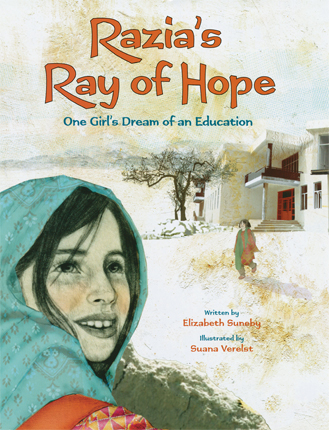| Razia's ray of hope : one girl's dream of an education (CitizenKid) Author: Suneby, Elizabeth | ||
| Price: $23.76 | ||
Summary:
A story about a young girl who must find a way to convince her father and brothers that she should go to school in Afghanistan.
| Illustrator: | Verelst, Suana |
| Accelerated Reader Information: Interest Level: MG Reading Level: 4.10 Points: .5 Quiz: 161632 |
Common Core Standards
Grade 3 → Reading → RL Literature → 3.RL Key Ideas & Details
Grade 3 → Reading → RL Literature → 3.RL Integration & Knowledge of Ideas
Grade 4 → Reading → RL Literature → 4.RL Key Ideas & Details
Reviews:
Kirkus Reviews (08/01/13)
School Library Journal (09/01/13)
Booklist (09/15/13)
Full Text Reviews:
School Library Journal - 09/01/2013 Gr 3–5—This story was inspired by Razia Jan, an Afghani woman who lived in the U.S. but returned to Kabul to build the first girls' school there. A fictional youngster named Razia longs to go to the newly opened school for girls but must have permission from her father and oldest brother. Both the prose and the plot are predictable-her relatives refuse: "Next you'll want Razia to go into town to shop by herself," says her father to the child's supportive grandfather. "Or for women to shed their burqas in public," her brother adds. In the end, the real Razia Jan appears to convince the men, and the child is permitted to go to school. In contrast, there is nothing ordinary about the mixed-media illustrations. Each spread is a combination of muted colors, block-print designs, and evocative collage portraits of elders, active children, and the blue backs of burqa-clad women, interspersed with photographs of everyday objects: a teapot, a wool blanket, colored pencils in the school. Back matter includes a glossary of Dari words, and suggested classroom activities and discussion. Also included is a short biography of Razia Jan and a photo of her with three grinning schoolgirls. The photo brings the fictional story to life, illuminating that part of the world in which girls beg to go to school, then bring their workbooks home to teach their mothers.—Toby Rajput, National Louis University, Skokie, IL - Copyright 2013 Publishers Weekly, Library Journal and/or School Library Journal used with permission.
Booklist - 09/15/2013 Inspired by the true story of Razia Jan, an Afghani American woman who has devoted her life to advancing the education of Afghani girls, this follows a fictionalized Razia as she begs the men in her family to be allowed to attend the new school for girls being built in her village. Even a supportive grandfather cannot sway the steadfast refusal of the patriarchy, so it is only by chance that her dream comes true. Razia’s yearning for school is described in rich, context-specific language: “They painted the door red, as bright as the flames of the tandoor.” Verelst’s mixed-media illustrations feel fresh and modern while remaining true to the rural environment, combining crisp, detailed pencil renderings with digital reproductions of traditional Afghani fabrics and photographs, situating Razia’s story firmly in the sun-bleached, rocky terrain of rural Afghanistan. The back matter includes a list of classroom-friendly activities that should help teachers encourage readers to appreciate the literary, artistic, and historical elements of this book. - Copyright 2013 Booklist.



